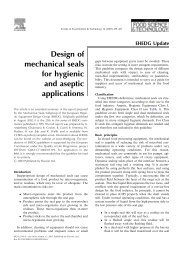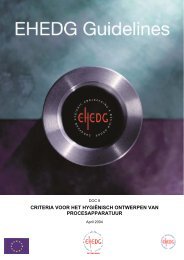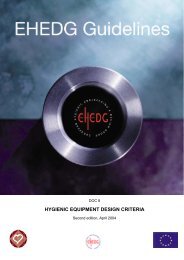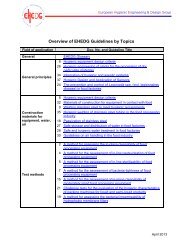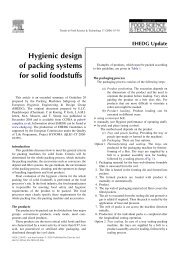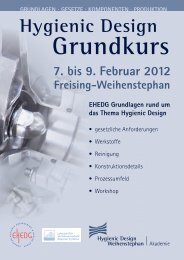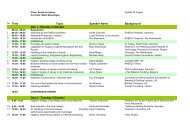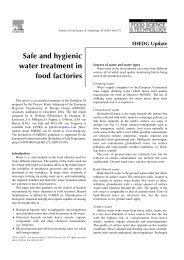Yearbook 2013/2014 - ehedg
Yearbook 2013/2014 - ehedg
Yearbook 2013/2014 - ehedg
You also want an ePaper? Increase the reach of your titles
YUMPU automatically turns print PDFs into web optimized ePapers that Google loves.
22 The importance of hygienic design: A process facility case study and checklist<br />
2. Piping and instrumentation diagram (P&ID). This<br />
involves one significant hygienic design principle:<br />
d. Hygienic design principle 2:<br />
Cleanability. During the definition of the P&ID for the<br />
processing line, the following aspects should be considered<br />
and included:<br />
• Identify all of the different equipment that are part of<br />
the process.<br />
• Establish cleaning methods (i.e., CIP, manual, etc.)<br />
and cleaning regimes.<br />
• Evaluate restrictions inw the process and determine<br />
alternative solutions to ensure that effective cleaning is<br />
achieved.<br />
In the cream cheese facility during the P&ID definition phase,<br />
it was determined that for the CIP cleaning of the scraped<br />
surface heat exchangers (SSHE), a reinforcement was<br />
needed to ensure effective cleaning of the system (Figure<br />
7). The red arrows represent the product flow and the pink<br />
ones CIP reinforcement.<br />
During the CIP cleaning additionally to the main route (red<br />
arrows) there is a flip that makes a closed loop with the<br />
SSHE, supported by a centrifugal pump.<br />
Figure 7. CIP cleaning route for the scraped surface heat exchangers (SSHE).<br />
3. Specifications for different suppliers. Once the P&ID is<br />
completed, the next step is to define the detailed function of<br />
the line (FDS), as well as the specifications for the quality of<br />
the materials to be used. Once all this information is compiled<br />
the specifications can be sent to the different suppliers in<br />
order to get an estimated quotation for the installation.<br />
Some hygienic design principles that are important to be<br />
considered when defining the specifications are:<br />
e. Hygienic design principle 2:<br />
Cleanability.<br />
• Identify the method of cleaning (e.g., CIP, clean-out-ofplace<br />
[COP], foam, manual cleaning).<br />
• Assess the capability of the equipment to handle<br />
frequent CIP temperature exposure.<br />
• Determine whether all of the equipment components,<br />
such as valves, are designed to be cleaned in place.<br />
• Ensure that the process connections of all the<br />
measurement devices are hygienically designed.<br />
• Decide how many process connections are needed.<br />
f. Hygienic design principle 3:<br />
Compatible materials. All materials that may come into<br />
contact with food should not be able to make the food unfit<br />
for consumption (e.g. toxic). As such, all materials used in<br />
the composition of food manufacturing equipment should be:<br />
• highly resistant to corrosion;<br />
• nonporous with smooth surfaces;<br />
• highly resistant to thermal variations;



